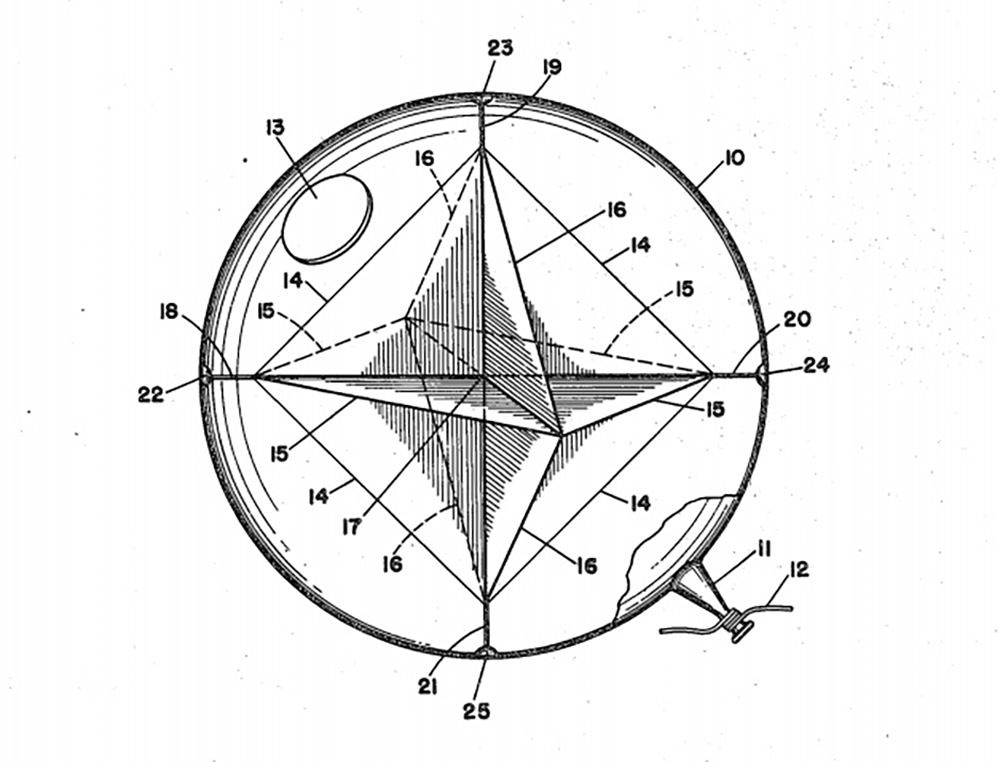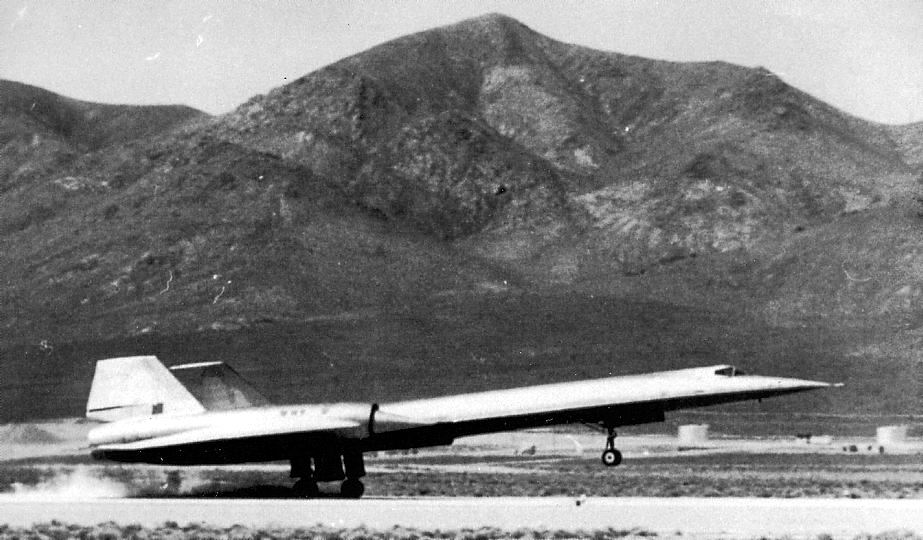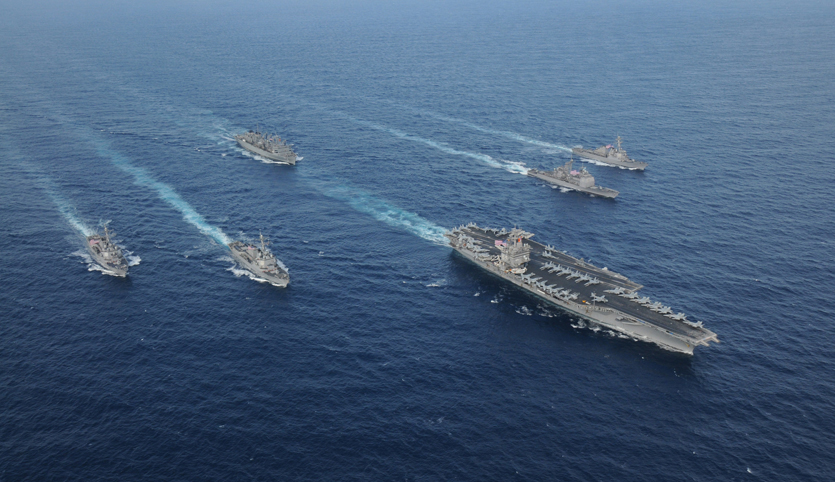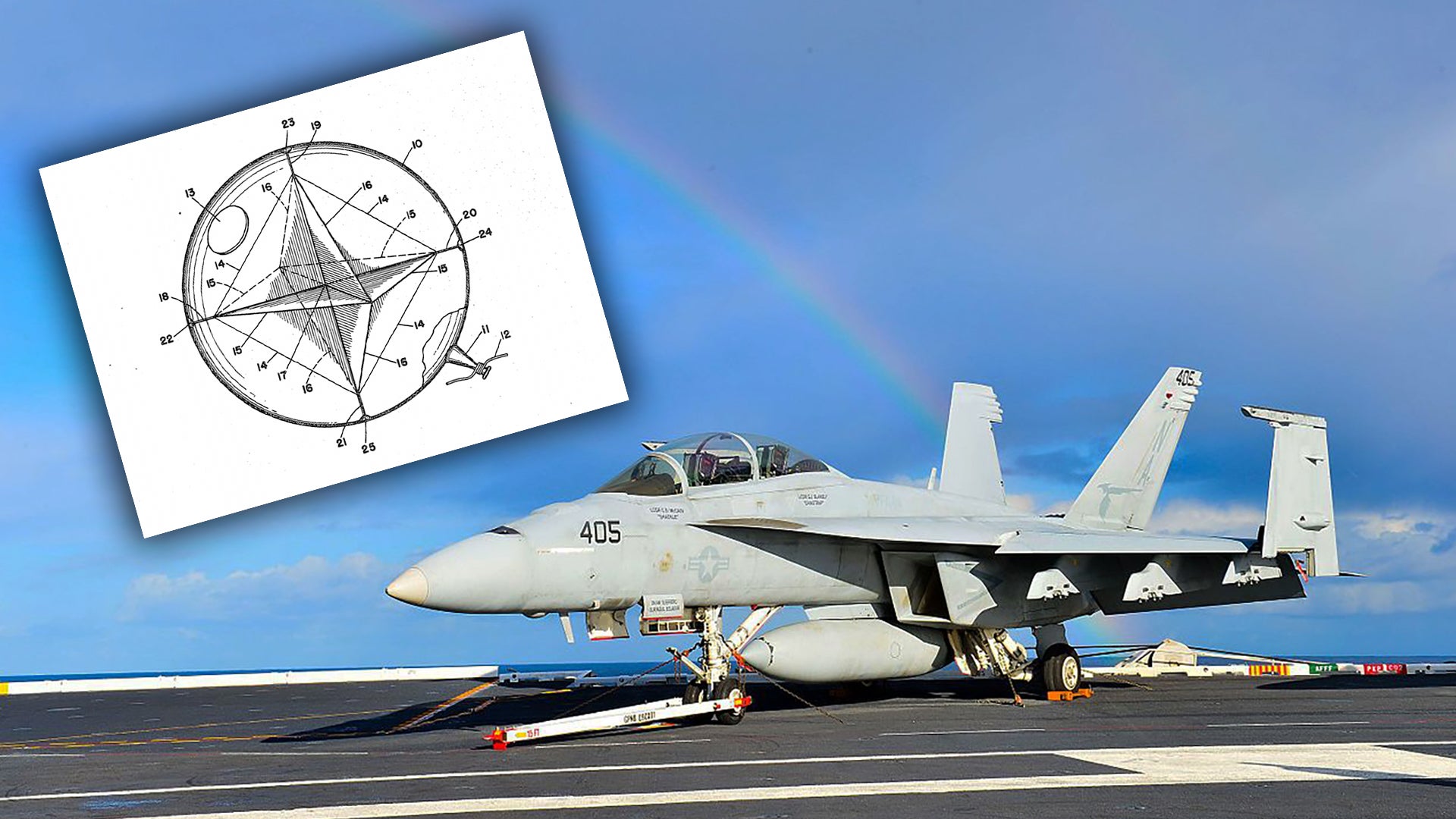Following the revelations that a series of bizarre encounters between Navy pilots and UFOs had occurred off the east coast of the United States from 2014 to early 2015, The War Zone set out in search of any possible explanation for at least some of these incidents that don’t involve fantastic origins or extremely advanced technology. Over the last month, we have identified one possibility, in particular, that is worth mentioning. Instead of anti-gravitational propulsion or flying machines from space, this possibility—and that is all it is, a possibility—has to do with specially designed radar reflector balloons and submarines, as well as a historical precedent for an obscure operational electronic intelligence gathering concept that first came to be during one of the hottest moments of the Cold War.
The description given of objects involved in numerous close UFO encounters with Navy pilots off America’s eastern seaboard during the 2014-2015 timeframe is akin to a ‘beachball’ or orb with a cube suspended inside of it with the cube’s corners touching or nearly touching its edges. This sounds amazingly bizarre and is more reminiscent of what we would expect from a sci-fi movie circa the 1980s than the classic flying saucer or even the large ‘Tic Tac’ that Navy pilots encountered back in 2004, but to me, it also sounded eerily familiar.
When I thought of round orbs with cubes inside them, balloons and radar reflector devices came immediately to mind. I began hashing out this possibility with my colleague Joseph Trevithick shortly after the reports came to light. The reality is that traditional high-altitude balloons and radar reflectors already go hand-in-hand.
Because a high-altitude balloon doesn’t have much, if any, of a radar cross-section, metallic radar reflectors, which come in a variety of geometric shapes, are strung below its gas envelope, thus providing a radar return so that it can be tracked. The combination can look pretty bizarre in and of itself and they are cumbersome and clumsy arrangements. But couldn’t this be simplified for more conducive deployment and better aerodynamics by just suspending the reflector inside the balloon itself? A similar arrangement is used for radar reflectors that float on the water or are strung up on ships, but what about one that has to travel through the atmosphere?
Just as I thought, an answer to that question has already been proposed. After searching sporadically over a number of days for what I envisioned in my mind, I found just that in U.S. Patent #2,463,517, titled “Airborne Corner Reflector.”

The patent was filed way back in 1945 and was granted in 1949. It is alarmingly similar in appearance to what the pilots had reported seeing multiple times over the Atlantic Ocean. In fact, a near miss encounter with one of these objects as described by Navy Super Hornet pilot Ryan Graves states that the object was likely standing still, floating in the air, when the Super Hornet blasted by at a too close for comfort distance. In other words, it wasn’t making any extreme performance maneuvers while within visual range. Instead, it was acting like, well, a balloon.
Hear Ryan Graves describe the encounter in a clip from History Channel’s To The Stars Academy-helmed show Unidentified:

Other statements from Graves and a squadronmate have pointed to the fact that these objects can stay in the air for many hours at a time. This is a characteristic also possessed by a balloon of some sort. Even the perceived threat from a collision with one of the objects and the Navy’s lack of interest in dealing with it at the time wouldn’t be as surprising as it is now if they were indeed balloons. Weather balloons and other high-altitude balloons are launched into the skies daily and fly among airliners without the ability to track or avoid them. You can read more about this reality here.
Getting back to the patent in question, it reads in part:
“While the invention is of paramount importance in ascending balloon assemblies, it may be used in fixed installations such as can be used for navigation. In the former case, the weight of a rain-soaked or ladened reflector adds to the drag of separate units and in the latter case the protection to the reflector afforded by the balloon multiplies its life several times. Upper wind velocities, i. e., at elevations of from 30,000 to 40,000 yards, heretofore unobtainable, may be recorded by use of the present invention. With prior devices such readings could not be obtained because these heights were not attained by the balloon and unit or at least not while it remained in recording range. As will be understood, the balloon is made of electrically non-conducting material. The device being collapsible can be packed into small space.
The elasticity of the supports and/or the reflector unit itself provides for the usual expansion of the ascending balloon. The unit does not cut off the balloon into isolated sections and accordingly it may be filled with gas through a single port. I prefer to seal the balloon after the reflector unit is secured in position. The seal may be a separate piece as illustrated, or may include the intake port. A typical balloon will be about six (6) feet in diameter, although a such [sic] smaller or larger one may be used. The points of the reflector surfaces are joined by rubber bands, as by spot vulcanization. The use of rubber bands or elastic reflector surfaces is to allow for the usual expansion of a rubber balloon as it attains great height with the resulting low atmospheric pressure…”
What’s most interesting is how it describes the ability to be packed into a small space. Being able to launch something just like this in a pre-packaged, all-up canister from a submarine—especially a submerged one—would be highly beneficial. Today, submarines can release canisters to the surface that deploy small aerial drones and it is even possible that balloons could be released from very shallow depths without the use of a canister of any type. Regardless, there is actually a historic precedent for clandestine operations where submarines launched balloons carrying radar reflectors as part of intelligence gathering operations.
Documents released by the Central Intelligence Agency describe submarine-launched balloon tests that were conducted by the CIA and the USAF as far back in 1955. By 1963, submarines were executing complex, high-stakes, and secretive operations to gauge the abilities of enemy air defense systems by launching radar reflector-toting balloons. In the awesome book Lockheed Blackbird: Beyond the Secret Missions, one of these missions is described in remarkable and highly relevant detail.

The A-12 Oxcart—the CIA’s precursor to the USAF legendary SR-71 Blackbird—possessed extreme speed and the first stealthy features ever intentionally deployed on an operational combat aircraft. But low-observable (stealth) design was in its infancy and the Skunk Works and the CIA needed a way to really gauge just how survivable the A-12 would be against the latest and greatest Soviet radar systems. The rest is history:
“During the Cuban Missile Crisis, the US intelligence community had monitored the construction of no less than 19 SA-2 SAM sites on the island and these provided the CIA, together with Oxcart [the codename for the A-12 spy plane program] planners, an ideal opportunity to determine the sensitivity of its associated radar receiver.
One night, a US Navy destroyer equipped with a Palladium transmitter positioned itself beyond the detection range of a Soviet “Tall King” A-band early warning radar situated near Havana. With its antenna protruding just above the horizon the destroyer produced a signal that appeared to be emanating from a US fighter out of Key West, making a high-speed dash towards the capital, Havana.
At a predetermined time, a US Navy submarine surfaced near Havana Bay, just long enough to time-releases a series of balloons carrying radar reflectors of varying sizes. The idea was that having detected the ‘aircraft’, the Soviets would switch on SA-2 target tracking radars in preparation for engaging the target. Release of the balloons ahead of the ‘target’ would produce a number of returns, of which the smallest reported would present the highest level of radar sensitivity.
The operation worked like clockwork. Cuban interceptors were also scrambled to hunt down the ‘intruder’, and when one of their pilots told his ground controlled intercept (GCI) controller that he had acquired the ‘target’ on his radar, the technician on the destroyer flicked a switch and the ‘US fighter’ disappeared.
After analyzing the intelligence data collected from this operation and by other means, the CIA’s concluded that Soviet radar capability would indeed be able to track and ‘lock on’ to an Oxcart, despite the aircraft’s radar attenuating design features.
Despite these discouraging findings, flight test continued.”
It is unclear if the successful espionage tactics used in this operation became more commonplace later on as enemy air defense systems grew more complex and capable. It would be strange to imagine that it wouldn’t have, but the world of submarine warfare is a dark and murky domain that is shrouded in extreme secrecy.
Fast forward to today and modern submarines have highly advanced electronic intelligence gathering capabilities—it’s a primary mission set that is often overlooked or misunderstood by the public. At the same time, they don’t really have a way to stimulate enemy air defenses organically in order to record these emissions and even communications that go along with them without surfacing, and even that is speculative and based on what we know about the 1963 operation. Being able to deploy balloons with various sized radar reflectors while submerged could be a relatively low tech, but highly effective way of doing this. By sneaking in or near enemy territory, releasing these devices under the right weather conditions, and raising their low-observable electronic intelligence gathering masts, they could theoretically improve the quality of the intelligence gathered remarkably.
In addition, submarines could deploy these air defenses-stimulating balloons within enemy territory during operations that are executed in cooperation with other assets. These could include strategic surveillance aircraft operating at standoff ranges, or stealthy reconnaissance aircraft operating at closer ranges, either of which could better soak-up radar emissions and communications from an enemy’s air defense network over a broad area. Leveraging space-based capabilities is also another possibility. The submarine’s ability to do so is more localized as it is limited by the distance to the horizon in relation to its electronic intelligence gathering mast’s height, at least when it comes to detecting land and surface-based air defense-related emissions. Under this concept, the submarine would just be a delivery system for the airborne reflectors and could maintain maximum stealth at all times.

Regardless, it is possible that the mission that occurred in 1963 in support of the CIA’s A-12 program was a progenitor of more mature capabilities that are in existence today, or maybe the tactic has been recently borrowed out of the intel community’s historic playbook. Testing how sensitive an enemy’s air defense capabilities actually are, let alone what the exact ‘electronic fingerprints’ are of its individual components and cataloging their geolocations, is far more important now than it was in 1963. Such intelligence would be extremely valuable, especially in an age of stealth technology where knowing exactly what your foe’s electronic order of battle is and what their integrated air defense system’s strengths and weaknesses are at any given time is absolutely key for the complex mission planning that allows assets to successfully penetrate enemy airspace and survive to do it again the next day.
Paired with modern materials science, one can imagine just how easily deployable and effective these balloons could be today. Radar reflector equipped balloons that are capable of being clandestinely launched from below the waves could also work in tandem with other similar balloons that carry small expendable electronic warfare payloads aloft instead of radar reflectors. These would confuse stimulated enemy radars even more and could potentially produce multiple ghost radar returns that exhibit extreme performance on a radar operator’s scopes. In other words, the large formations as described by radar operators in some of these encounters could be a mix of electronic warfare and radar reflector payload-carrying balloons. Such a capability could be used during a time of way to distract the enemy as well as for intelligence gathering.
In fact, during the Nimitz incident in 2004, a bunch of targets appeared on radar over the Channel Islands and progressed south towards the carrier group at the speed of a Cessna, but at high altitudes, with some of those targets quickly dropping to sea level in an instant before shooting back up. Recently, I looked into a chaff cloud that originated from this exact locale and progressed to the same exact area where the Nimitz was operating at a speed of around 100-110 knots. The discovered the high velocity was due to the jetstream that was positioned directly overhead and pulling the mysterious cloud along at an impressive clip. The same could have been the case for a group of balloons launched during the Nimitz Carrier Strike Group’s training back in 2004.
In addition, the targets that appeared during the Nimitz encounters actively jammed the radars of fighter aircraft. Once again, this may have been an electronic countermeasures payload on some of these devices.
With this in mind, is it possible that what Nimitz Carrier Strike Group radar operators saw was a bunch of radar reflector and/or electronic warfare payload-carrying balloons? It seems at least worth considering, especially considering the alternative explanations.

Obviously, this doesn’t explain the Tic Tac encounter with Super Hornet pilots in any way, but they could be mutually exclusive events or were part of a coordinated event of some type to test multiple clandestine technologies against the very best air defense capabilities on the planet at the time.
Regardless of the Nimitz event, a hypothetical picture is emerging of what could be an extremely useful classified ecosystem of capabilities and tactics that could be employed to actively mine critical info on air defense systems located in an enemy’s own backyard or even distract the same enemy’s air defenses during a time of war. And here’s the catch—such a capability may not belong to the U.S. alone, or even at all, at least in current times.
It could belong to an adversary who needs a way to collect critical intelligence on American radar systems in areas that their most capable systems frequent for training. This is particularly relevant when it comes to observing a carrier strike group during spin-up operations before deployment and especially those that are packing new advanced air defense hardware, which was both the case during the Tic Tac incident in 2004 and some of the encounters in 2014-2015. You can read more about this peculiar similarity in this past exclusive of ours.
Diving deeper into our patent search, we discovered another balloon concept that was far more advanced—one that could be able to be actively controlled and make abrupt maneuvers.
U.S. Patent #7341224B1, which was filed in 2004 and awarded in 2008, describes a Miniature Robot Surveillance Balloon that has thrusters to control its flightpath and can carry an electrical-powered payload aloft.

The patent reads in part:
A miniature surveillance balloon system is described that can be used in military and public safety situations for real-time observations. They are low-cost and expendable, and typically are deployed in clusters. Balloons may act individually or alternately clusters may act robotically (in unison) without command input at times. Balloon systems may be deployed by dropping from aircraft or by some form of artillery or rocket launch mechanism.
In some optional embodiments, balloons may have thruster mechanisms to facilitate lateral movement. Balloons may also be used individually or in clusters as a weapons system.
…
In general, the balloon system may be encouraged to travel in the vertical direction by releasing gas from the bag to descend and by either injecting gas from the compressed gas cylinder and/or jettisoning weight to ascend. The balloon system may optionally include some form of directional thrusters to allow it to travel in a specific horizontal direction and/or travel in a vertical direction at a rate faster than the effects of lift and weight would allow. Thrusters may be provided by solid rocket propellant, or alternately by miniature engines that burn hydrogen gas from the bag or from the gas cylinder.
The patent for the swarming balloons goes on to describe its fuel cell, data-link, and other components that are quite interesting.
We have no idea if something like this was ever actually developed, but it is another good reminder that somewhat exotic applications for older technological concepts could result in capabilities that seem alien at first glance. And really, that is the beauty of these balloon concepts, they have a cover story built-in—they would appear somewhat out of this world to even a trained observer. Throw in an LED light and you are talking about something that can look extremely strange, especially to a fighter pilot moving past it at high speed. Its small size would also make it hard to spot in the first place and depending on its radar reflector configuration, it could exhibit a highly variable radar cross-section.
If anything else, a submarine-launched balloon system designed to catalyze clandestine electronic intelligence gathering is a remarkably creative, but obscure concept that existed nearly 60 years ago. Does it explain every aspect of every detail of every incident Navy personnel have described over the last 15 years? No. But nothing else does without jumping to some extremely reality-warping conclusions. At the same time, as I have stressed repeatedly, it is entirely possible, if not probable, that there isn’t a monolithic answer to the UFO question and that multiple truths exist regarding the topic as a whole and even regarding the individual cases that are making headlines today.

In the end, we have to look at every single possibility and evaluate each one of them with an open mind. I promised my readers that I would dig as deep as possible to find any potential existing technological answers that could address even parts of what highly-trained and credible witnesses are seeing, regardless of what or whose narrative it may fit. At this time, without going into the well-established and frankly, at this point, still relevant theories that include government cover-ups of world-changing technologies or even craft visiting the Earth from other worlds, this is the closest I have come to a valid answer.
And yes, I do realize that even implying that what people describe as unexplained objects could be ‘balloons’ is highly inconvenient considering the stigma surrounding that explanation. But in this case, that doesn’t make it any less worthy of examination considering we aren’t talking about some garden variety weather balloons here and there would be a real reason for any military power to keep such a capability secret. The fact that there is an actual precedent for employing a similar concept secretly during the Cold War also adds significant weight to the possibility.
In the end, that’s all this is, a possibility. One of a number to mull over as we all continue on what has become an increasingly historic and bizarre quest for the truth.
What do you think? Let us know in the comments below.
Contact the author: Tyler@thedrive.com
